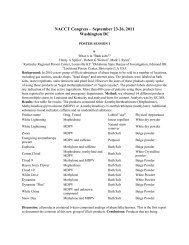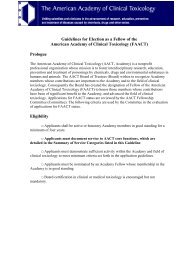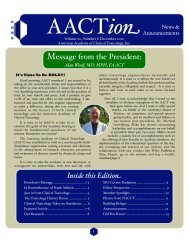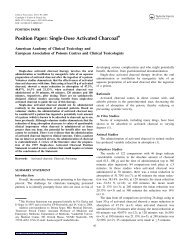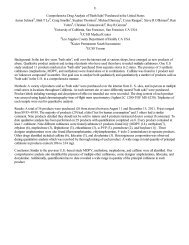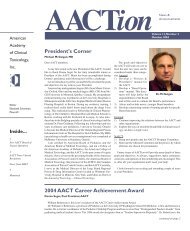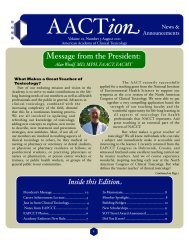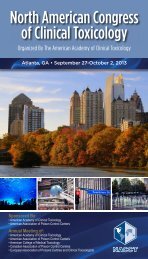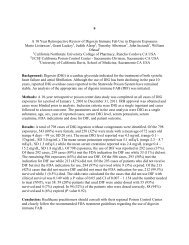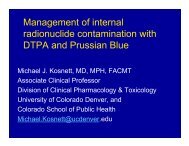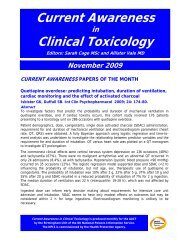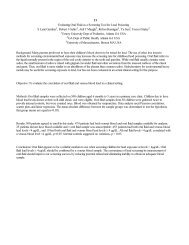Posters IV - The American Academy of Clinical Toxicology
Posters IV - The American Academy of Clinical Toxicology
Posters IV - The American Academy of Clinical Toxicology
You also want an ePaper? Increase the reach of your titles
YUMPU automatically turns print PDFs into web optimized ePapers that Google loves.
life-threatening bleeding. Case Report: A 34 year-old Chinese female attempted suicide by ingesting 7<br />
boxes <strong>of</strong> d-Con while 33 weeks pregnant. She was treated with oral phytonadione (up to a maximum dose<br />
<strong>of</strong> 40 mg twice daily) and experienced no hemorrhage or complications. Her PT/INR peaked on day 3<br />
post-ingestion at 87.1/7.14. She was released from the hospital on day 43 with a normal PT/INR, and<br />
continued to take phytonadione. On day 8 post-ingestion, the fetus was delivered emergently by c-section<br />
after experiencing decelerations and had APGARs <strong>of</strong> 1 and 7 at delivery. <strong>The</strong> female baby began seizing<br />
and required intubation. She bled significantly from the cord and endotracheal tube. Coagulation studies<br />
showed a PTT >225, PT >140, and INR >11.4 with a hematocrit <strong>of</strong> 25. Vitamin K <strong>IV</strong> and FFP were given<br />
to correct anticoagulation and control bleeding. A CT scan <strong>of</strong> the head showed intraventricular<br />
subarachnoid, subdural hemorrhages, and diffuse cerebral edema. Despite aggressive medical treatment,<br />
including ventricular drainage, the infant's condition deteriorated, and life support was withdrawn<br />
resulting in death 3 days after delivery. Case Discussion: Warfarin crosses the placenta freely but it is<br />
unclear how well brodifacoum crosses. Vitamin K1 has been shown in human studies to poorly cross the<br />
placenta, including one study in 1982 that found no detectable levels in the cord blood <strong>of</strong> term infants<br />
although adequate levels were present in mothers. Vitamin K1 during pregnancy is generally indicated for<br />
maternal hypoprothrombinemia and for prevention <strong>of</strong> hemorrhagic disease <strong>of</strong> the newborn induced by<br />
maternal drugs. <strong>The</strong>re is only one documented case report <strong>of</strong> a pregnant poisoning with brodifacoum (at<br />
22 weeks gestation) and there were no fetal complications. Conclusions: This is the first case report <strong>of</strong><br />
infant demise after maternal ingestion <strong>of</strong> brodifacoum. Brodifacoum in high doses significantly crosses<br />
the placenta, and phytonadione orally in standard doses does not cross the placenta enough to reverse<br />
anticoagulation.<br />
303<br />
Comparative electrocardiographic effects <strong>of</strong> antipsychotic drugs after overdose<br />
Salem M Fathalla 2 , Janine Gray 1 , Simon H Thomas 2<br />
1 Janine Gray Statistical Consultancy, East Bolden UK 2 Newcastle University, Newcastle UK<br />
Background: Antipsychotic drugs are commonly involved in episodes <strong>of</strong> drug overdose. Some<br />
antipsychotics may delay cardiac repolarisation, leading to QT prolongation and an increased risk <strong>of</strong><br />
torsade de pointes. Effects on the QRS interval, reflecting sodium channel function and conduction<br />
velocity, have also been reported.This study was performed to compare EKG effects <strong>of</strong> individual<br />
antipsychotic drugs after overdose. Methods: Observational cohort study using EKGs collected at 25<br />
mm/s from all adult patients with first presentation <strong>of</strong> antipsychotic drug overdose in Newcastle between<br />
2000 and 2008. EKGs were analysed blind to patient characteristics and exposure using a digitizer.<br />
Relationships between antipsychotic drugs and QT and QRS intervals were examined by multivariate<br />
analysis. Results: Of 443 first presentations with reported antipsychotic overdose, 364 had at least one<br />
EKG available. In 46 (12.6%) episodes QTc prolongation (>450 ms in males, >470 ms females) was<br />
demonstrated but there were no QTc intervals > 500 ms. QT intervals were correlated with RR interval<br />
and age, inversely correlated with plasma potassium concentration and were longer in females and those<br />
taking thioridazine in overdose (Regression coefficient 16.25, 95% CI 7.7, 24.7 ms). No significantly<br />
different QT effects were detected for other individual antipsychotics. <strong>The</strong>re was a weak positive<br />
relationship between QRS interval and age. QRS intervals were shorter with haloperidol (Regression<br />
coefficient -7.0, 95% CI -12.4 to -1.6, ms) and longer with quetiapine (Regression coefficient 6.0, 95% CI<br />
2.2 to 9.8, ms). Conclusions: Severe QTc prolongation is uncommon after antipsychotic overdose.<br />
Lengthening <strong>of</strong> the QT prolongation was associated with thioridazine overdose, which has also been<br />
linked with QT prolongation and torsade de points in normal therapeutic use. <strong>The</strong> apparent link between



